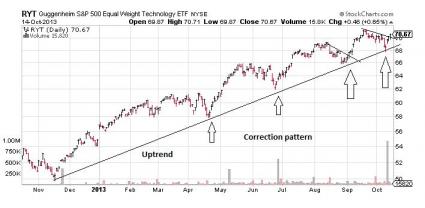There seems to be an undercurrent in the market where many traders believe stocks are near fair value. The rally in 2013 has been mostly a function of PE multiple expansion, as the profit growth picture has not shown material strength. 4-quarter trailing operating earnings per share for the S&P 500 have risen just 1% year over year between Q2 2013 and Q2 2012. Moreover, with the government shutdown there may be some marginal pressure on U.S. growth in Q4, but this is offset by improved economic prospects in Europe and Japan.
One way to value equities:
There are a number of ways to value the equity market, but one popular measure is the 12 month forward PE ratio. Investors like to price the market on the outlook for earnings. Earnings estimates are usually optimistic, and this creates a situation where earnings can be revised down over time. However, this dynamic is standardized by looking at a history of the forward PE ratio.
Forward PE ratios by sector:
Let’s take a look at the 12 month forward PE ratio for the ten major sectors of the S&P 500 for insight into the market’s valuation. The table following displays the 12 month forward PE ratio as of last Friday, and the average and median values since May of 1999. It also contains a look at the difference between the current forward PE ratio and the average adjusted for standard deviation. We’ll call that value the z-score. The z-score indicates how much the 12 month forward PE is above (positive) or below (negative) average, and the magnitude of the difference from average in standard deviations. The z-score helps to standardize valuation across sectors. Some sectors trade at higher multiples than others. Lastly, there is a column for the change in PE ratios since August outright and on a percentage basis.

Thoughts On The Table:
The table indicates that eight of the ten sectors are actually trading cheap to their average. However, the differential is not material. This is consistent with the idea that the market is roughly near its fair value, but slightly leaning toward the cheap side of valuation. Values -1.0 or lower would tend to argue for a cheap sector.
The IT sector is the most inexpensive sector relative to the average. The z-score is -0.677 and lower than the peer group.
Telecom was the next cheapest group. Industrials were a close third. The market is not paying up for industrials which is consistent with the sluggish growth picture.
The most expensive group was the utility sector. The search for yield and desire for stability may be at work in lifting the valuation of this group. Further, slow earnings growth argues for defensive exposure.
The material sector was the next most expensive, but trading near its average forward PE. The market is not willing to pay a material premium for the commodity sector given the still slow growth outlook.
It may be noteworthy that the market is not overly pessimistic about the consumer discretionary sector. The discount to average is small despite worries over soft back to school spending, adverse fall weather for apparel sales, and higher mortgage rates crimping housing and refinance activity. Autos sales are a bright spot.
Every sector has seen PE ratio expand since August. On a percentage basis, the biggest increase occurred in the telecom sector followed by financials. The smallest increase occurred in consumer staples.
Investors May Look To Chase Return:
Looking at the HFRX indices, hedge fund community returns are badly lagging the S&P 500. The HFRX Equity Hedge Index was up 7.0% year to date through October 10. Event driven and special situation were the categories with the greatest return up 14.5% and 11.1% respectively. By comparison, the total return for the S&P 500 was up 20.7%.
With the poor performance in the professional community, it is possible investors do some return chasing into the end of the year. This may be especial true if Washington calms down and the debt ceiling and government shutdown are resolved. The technology sector may be a place where investors look to place money given its cheap relative valuation.
Ways To Play:
The chip sector may be one place to look for year-end strength. The PowerShares Dynamic Semiconductor Portfolio (PSI) has already broken into new high territory, and it looks like the Market Vectors Semiconductor ETF (SMH) is set to follow.

The SPDR Technology Sector ETF (XLK) is a blanket way to find exposure to technology, but it has lagged the overall market up 12.8% through October 11. The PowerShares Dynamic Technology Sector Portfolio (PTF) and the Guggenheim S&P 500 Equal Weighed ETF (RYT) have posted much stronger results up 25.2% and 27.7% respectively.

Individual technology stock to check out include Tibco Software (TIBX), Sandisk (SNDK), Xilinx (XLNX), Harris Corporation (HRS), and Ubiquiti Networks (UBNT). These stocks are all Zacks Rank #1 (Strong Buy). They have seen signficant upward momentum in earnings estimate revisions.
In Conclusion:
Technology looks like the most inexpensive sector in the equity market and may attract money into year-end if and when the events in Washington DC normalize. Investors looking to the sector may want to check out the ETF space for exposure. Semiconductors via PSI or SMH and the broad technology sector basis PTF and RYT are a few suggestions. Those looking for exposure via individual equities should check out Zacks Rank #1 names TIBX, SNDK, HRS, XLNX, and UBNT.
